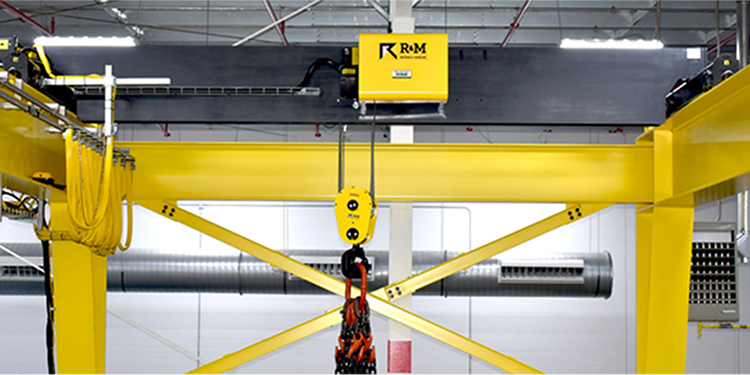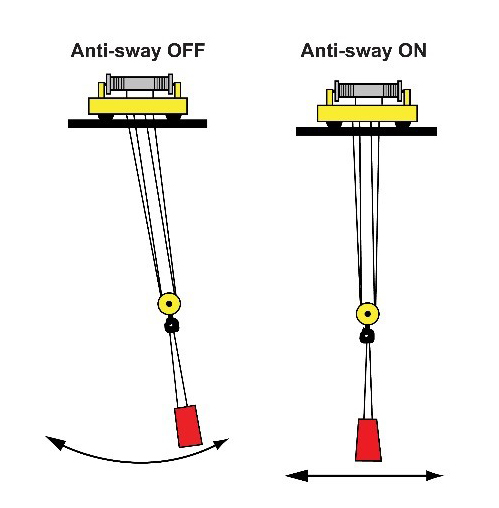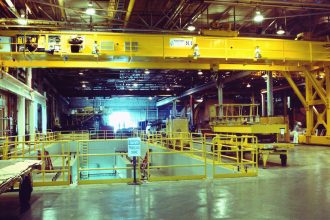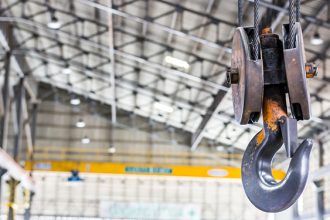Overhead Load Sway Control Technology Improves Safety, Productivity

When an overhead crane and hoist system transports a load, the laws of physics dictate that the suspended load will naturally sway when the travel motion starts or stops. Similar to a pendulum on a grandfather clock, the farther the load is from the hoist, the more pronounced the swing. Because a swinging load may potentially come into contact with personnel, equipment, materials, or facility structures it could become a hazard. Moreover, it can be challenging and time consuming for an operator to manually compensate for load sway. For both reasons, adding overhead load sway control technology to a crane can improve safety and productivity.
What is overhead load sway control?

Illustration courtesy of R&M Materials Handling
Experienced overhead lifting equipment operators manually compensate for load sway using the system’s controller, explained Erin Drake, Associate Director of Product Support and Marketing at R&M Materials Handling Inc. This process is known as settling the load.
“An operator can counteract the sway by jogging or reverse plugging the crane’s bridge or trolley in the opposite direction,” she said. “To do this they’re constantly looking between the bridge and trolley and the load as they manipulate the controls. It’s even possible for operators to steady smaller, lighter loads by hand.”
Conversely, a crane equipped with overhead load sway control technology automatically settles the load.
“Sway control technology uses a mathematical calculation to predict and counteract the natural pendulum effect that occurs when starting or stopping a travel motion,” Drake continued. “The technology directs the crane’s drives to stop the sway by accelerating or decelerating travel speeds or reversing direction. This automatically keeps the load centered under the hoist, with no interaction required of the operator.”
Different original equipment manufacturers’ (OEMs) overhead load sway control technologies employ different calculation methodologies, she said. “For the most part, however, the calculation factors in variables such as the weight of the load and the distance between the center of the hoist’s rope drum and the load.”
Overhead load sway control technology is available for new crane and hoist installations, Drake added. She noted that, in certain situations, the technology can potentially be a retrofit to existing equipment.
What types of applications benefit from sway control?
There are several applications where overhead load sway control technologies offer benefits. These include:
Fragile or Delicate Item Movement
When the load is exceptionally delicate, fragile, or easily damaged, having automatic sway control technology is ideal. For example, a large sheet of glass can easily crack, chip, or shatter if the sway causes an impact with a stationary object. Further, items like a sheet of glass have an enormous surface area that is likely to produce excessive drag if transport is not edge first. This can magnify the degree of sway, making it more difficult for an operator to compensate by manually manipulating the controls.
High Value Item Positioning
Complex, expensive, and sensitive assemblies and components — such as satellites or other high-tech equipment — often require extremely precise positioning and placement. Without sway control, it is exceptionally hard to achieve the fine degree of precision necessary to complete tasks without damaging high value items.
Limited Space Facilities
Crowded facilities with tight working spaces are more likely to sustain impacts from a swaying load than those with ample envelope clearances. Adding overhead load sway control technology significantly reduces the safety risks to personnel, equipment, and facility structures posed by less precisely controlled pendulum swing.
Extremely High Lift Heights
The greater the distance between the load and the hoist, the higher the degree of pendulum swing. This increases the chance of the load impacting facility structures, surrounding equipment, or employees. Utilizing sway control technology eliminates the potential for damage or injury in high lift applications.
Longer Travel Runways
Cranes that transport loads over long distances benefit from overhead load sway control technology because the load automatically remains centered for the entire trip. Without load sway control, the operator must continuously adjust the controls to counteract the pendulum effect. This significantly increases load travel and positioning time.
Repeated Pick and Place Workflows
For operations that make frequent load movements throughout a shift, overhead load sway control technology dramatically increases productivity. Because the technology automatically counteracts the swing of the load, operators do not have to spend time making manual adjustments. This can cut load cycle time by as much as 50%. Additionally, the automatic adjustments reduce wear on crane components, lowering overall maintenance costs while extending the life of the equipment.
What other technologies improve overhead lifting safety and productivity?
Operations considering the addition of overhead load sway control technology may also benefit from other optional features, noted Drake.
“When working with a crane builder, be sure to explain your process and your goals for it. For example, sway control can help with speed and efficiency; frequent, repetitive motions; and fine precision placement,” she explained. “However, there are also other solutions available that can help improve those factors while enhancing overall operational safety.”
Several smart crane technologies — including those that mitigate off-center lifts, alert operators to the potential for collisions, restrict travel areas, and more — are explored in an Overhead Alliance webinar. The “Overhead Lifting Safety Innovations Panel Discussion” is available to help overhead crane and hoist operators, maintenance personnel, owners, safety professionals, purchasers, and specifiers. It addresses both safety and productivity challenges associated with overhead lifting.
Learn More About the Overhead Alliance
MHI’s Overhead Alliance includes the Crane Manufacturers Association of America (CMAA), the Hoist Manufacturers Institute (HMI), and the Monorail Manufacturers Association (MMA). All three industry groups are a part of the Occupational Safety and Health Administration’s (OSHA) Crane, Hoist and Monorail (CHM) Alliance. Through this collaboration, the organizations provide information, guidance, and access to training resources. These tools help protect the health and safety of worker using hoists, cranes, and monorails. For more information, visit mhi.org/solutions/overhead-alliance.



